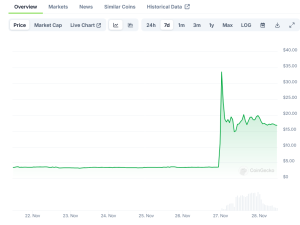While cryptocurrencies and equities (stocks) may share some similarities, they largely differ in regard to volatility.
As such, the evolution of blockchain technology and the myriad of coins and tokens trading on a global, decentralized, “always-on” 24/7/365 marketplace is seen by some as a digital gold rush. Often compared to a Wild Wild West where fortunes can be made and lost overnight, cryptocurrency markets have captured the ambition and imagination of a cross-generational array of traders.
Although cryptocurrency trading can be lucrative, its significant risks weigh heavily; for every crypto millionaire, there are likely hundreds or thousands losing money. They do so largely for a handful of reasons, falling prey to:
- FOMO (fear of missing out) – buying into loud projects that may have already hit their all-time-highs,
- Extreme greed when investing because they don’t dedicate enough (or any) time to analyzing patterns.
In addition to learning strategies and understanding the complex foundations and mechanisms of the crypto market, traders must make efforts to control the emotional responses that inevitably emerge from a fast-paced market. The psychology of trading is a beast of its own that many novice traders fail to consider.
However, advances in digital technologies allow traders to supplement their organic trading efforts with automated systems based on best practices or algorithms. In the following article, we’ll highlight various types of trading strategies, key differences, and how they apply to cryptocurrencies.
Trading In The Digital Era
In today’s world, it’s incredibly easy to access cryptocurrency markets as a trader. Apps such as Robinhood and exchanges like Coinbase and Gemini make it possible for virtually anyone to get set up and access speculative assets, such as Dogecoin, for better or for worse. With a few extra steps, traders can access even more speculative lower-market-cap coins using something like Uniswap or Sushiswap.
Novice investors tend to be at a clear disadvantage because they lack experience of having accumulated enough skin in the game to understand losses or their triggers. For example, many of today’s best traders are able to rest on their laurels of having “gotten in early” into projects like Bitcoin and Ethereum, and are now able to make much bolder trades since their technically at a profit from when they started.
However, for the novice trader who is buying into markets at a much higher price than, let’s say, 2017, the downside is much higher. As such, trading psychology weighs a bit heavier. For example, one of these two lines of thought seem to arise:
- “I want to find the next BTC early on, and I want to make a LOT of money, so I’m going to take a much bigger risk on this project because the payoff will be even bigger!”
- “It seems everything is way too high right now, maybe I’ll just wait until the markets go down, I don’t want to lose all my money!”
While this article isn’t meant to be construed as financial advice, being too aggressive or too passive can both be hindrances to successful trading, and it’s very tricky for novice (and, frankly, many experienced) traders to find a functional medium.
We mentioned digital technologies have created ways to bypass many trading constraints and empower inexperienced traders to become profitable. Digitization has streamlined access to information.
In turn, trading platforms have adjusted their practices to account for new audiences seeking financial exposure. For example, many trading platforms acknowledge the social component of trading, and allow for visibility between experienced traders and less experienced ones. As a result, strategies such as day trading or swing trading have been expanded to include copy, mirror, and social trading.
Different Types of Trading
Mirror, copy, and social trading tend to have a common denominator: they rely on the experience of others to identify, invest and make profits from financial markets. Of course, this comes with its own risks, but the logic is that the platform can sort the best traders to follow by making their historical performance visible.*
*Historical performance does not guarantee or predict future performance, so be aware of your risks and downsides.
Let’s take a look at each of these types in a bit more detail.
Mirror trading
Mirror trading is the process of using algorithmic determinants to copy the most successful trades and patterns of experienced traders without being subject to decisions based on their own emotions.
Ongoing mirror trading means that participants are aligning their financial decisions to that of an already established trader.
One of the attractive features of this approach is that not everyone who engages in mirror trading has to have any experience or knowledge of the assets that they have decided to trade. However, the actual traders being mirrored are usually required to have some technical understanding in order to implement their selected algorithms on their trading account.
This will vary per platform, but it would be unwise for a platform to support the mirror trading of inexperienced traders.
Copy-trading
Copy trading also involves mimicking other people’s trading behavior. However, unlike mirror trading in which traders implement algorithms, copy trading allows users to copy the opened positions in real-time, helping traders to leverage someone else’s knowledge. As such, both strategies can be leveraged by novices and established traders alike.
Existing trading platforms such as eToro offer traders opportunities to scan through individual traders’ profiles and see their investments in real-time.
Social Trading
Social trading, as its name suggests, social trading uses the information found on platforms such as eToro and makes decisions based on the profitable trades of other traders. It also takes into account predictions and patterns explained by other traders.
While social trading is mostly attributed to platforms that directly link to trading, the phenomenon has expanded in other sectors in which information about trading is disseminated, such as Reddit, Discord, and even Telegram.
What’s the Difference Between Copy Trading, Mirror Trading, and Social Trading?
It’s important to note that the aforementioned trading processes are usually geared towards investors who don’t have enough time to spend analyzing charts, reading reports, or following the market. They all sound similar, but they differ in their mechanics and value propositions.
Mirror and copy trading also decrease human error and counteract the negative impacts of human emotions, which are paramount if one wants to become a successful trader.
So, what’s the difference? Social trading adds the human component to the entire process and allows traders to make decisions based on their findings. Mirror trading, on the other hand, is not the outright copying of a trade, but involves instead creating an algorithm that offers an outlook of the best traders from a number of experienced traders.
How Can Trading Strategies Be Applied To Crypto?
Contrary to the approach of many cryptocurrency novices, cryptocurrency markets are atypical from more traditional financial markets. For one, due to the low level of liquidity, cryptocurrencies are highly volatile. Driven by market sentiment, crypto markets are heavily impacted by positive or negative news about market conditions.
As such, cryptocurrency is seen as an immature asset class in which the data for successful long-term trading strategies is lacking.
However, nimble traders can still learn to augment their trading approaches to profit regardless of bull or bear cycles. Trading strategies such as mirror trading or copy trading can be applied to any sector; however, novice traders should always take the information with a grain of salt.
These sorts of trading strategies also impact the platforms of choice for more advanced traders. For example, Binance and other established exchanges simply don’t have the infrastructure to support the copying or mimicking of the trades of other users.
Taking the market sentiment approach into account, social trading is a very interesting lens to use, should one know how to implement it successfully. Information dissemination often occurs on decentralized places or standard platforms like Telegram or Discord. Traders can scan and assess the most profitable trades and create their trading strategies based on these resources; sifting through coal to find diamonds can be a full-time job.
Some traders can even use Signal groups to connect their crypto trading bots to automatically trigger a buy/sell order based on certain sentiments. Therefore, strategies involving bots can be implemented when trading cryptocurrencies. While many platforms require users to have a high level of trading knowledge and expertise before successfully deploying a crypto trading bot, some offer intuitive interfaces that let beginner traders simply drag and drop indicators and strategies.
As the cryptocurrency market ecosystem evolves, so will the technology traders use in an attempt to be at the tip of the spear. Bots can help traders avoid emotional trading and shelter the storm in highly volatile market conditions.
The post Copy Trading, Mirror Trading, Social Trading of Cryptocurrencies appeared first on CoinCentral.






















